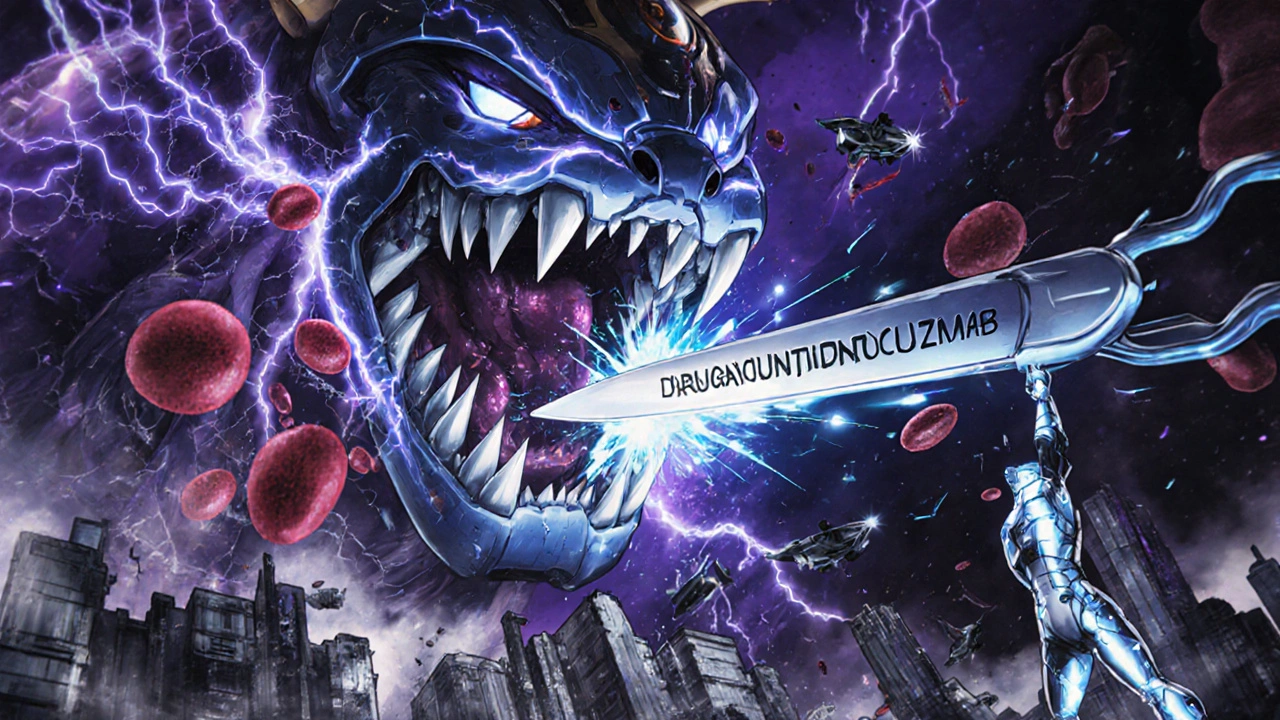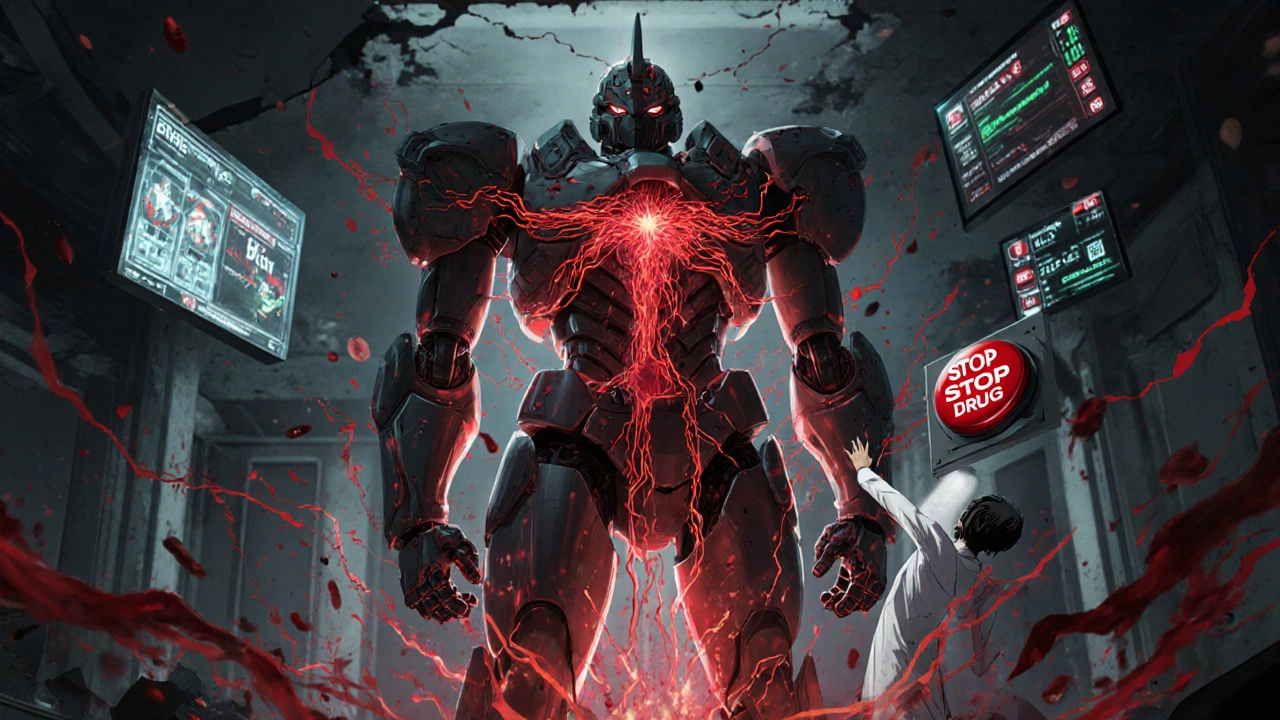Drug-Induced DIC Risk Calculator
This calculator uses the International Society on Thrombosis and Haemostasis (ISTH) scoring system to assess risk of drug-induced disseminated intravascular coagulation. Enter lab values to determine if overt DIC is present.
What Is Drug-Induced Disseminated Intravascular Coagulation?
Disseminated Intravascular Coagulation (DIC) isn’t a disease you catch-it’s a catastrophic breakdown of your body’s clotting system. It happens when your blood starts clotting everywhere at once, clogging tiny vessels and then bleeding out everywhere because the clotting resources are gone. When drugs trigger this, it’s called drug-induced DIC. It’s rare, but deadly. About 1.2% of all serious adverse drug reactions reported globally lead to DIC, and mortality rates can hit 60% if not caught early.
Unlike sepsis or trauma-induced DIC, drug-induced cases often fly under the radar. Many medications linked to DIC don’t even mention it in their official prescribing information. That means doctors might miss it-until it’s too late.
Which Drugs Are Most Likely to Cause DIC?
Not all drugs carry the same risk. Some are quiet killers. Based on global adverse reaction data from the WHO’s Vigibase, eight classes of drugs stand out as major triggers:
- Antineoplastic agents (cancer drugs): Gemtuzumab ozogamicin has the highest risk (ROR 28.7), followed by oxaliplatin and bevacizumab. These are often used in chemotherapy regimens and can damage blood vessel linings, triggering clotting.
- Antithrombotic agents: Dabigatran, a direct oral anticoagulant, was linked to 94 cases of DIC. It’s not supposed to cause clots-but in some people, it flips the script and turns the body against itself.
- Antibacterials for systemic use: Vancomycin and other antibiotics have shown weaker but still significant links. The mechanism isn’t fully understood, but immune reactions and endothelial damage likely play a role.
Recent FDA data shows a 23% year-over-year spike in DIC reports tied to monoclonal antibody therapies-drugs like rituximab and trastuzumab. As these become more common in cancer and autoimmune care, so will these reactions.
How Do You Spot Drug-Induced DIC?
There’s no single test. Diagnosis relies on patterns. The International Society on Thrombosis and Haemostasis (ISTH) scoring system is the gold standard. You add up points based on four lab values:
- Platelet count: Below 100 × 10⁹/L? That’s 1 point. Below 50? Add another.
- Prothrombin time (PT): More than 3 seconds longer than normal? 1 point. More than 6? 2 points.
- Fibrin degradation products (like D-dimer): Normal? 0. Slightly up? 1. Strongly elevated? 3 points.
- Fibrinogen: Below 1.0 g/L? 1 point.
If your score is 5 or higher, you have overt DIC. Most patients with drug-induced DIC show:
- Platelets under 50 × 10⁹/L
- D-dimer levels 10x above normal
- Fibrinogen below 1.5 g/L (sometimes below 80 mg/dL-this is a red flag)
- Prolonged PT and aPTT
Clinicians often miss it because symptoms look like other things: unexplained bruising, bleeding from IV sites, sudden drops in blood pressure, or organ failure. But if a patient on oxaliplatin or dabigatran suddenly starts bleeding or clots, DIC must be ruled out within hours.

Why Is Stopping the Drug So Critical?
In sepsis-induced DIC, you fight the infection first. In drug-induced DIC, you stop the drug-immediately. No delay. No waiting for confirmation. If you keep giving the drug, you’re feeding the fire.
Case reports tell the story. One 62-year-old man on oxaliplatin developed DIC after his third infusion. He bled from his gums, had blood in his urine, and his platelets crashed to 18 × 10⁹/L. The oncologist didn’t suspect DIC until a hematologist reviewed the labs. Once they stopped the drug and started transfusions, his numbers slowly improved. If they’d given another dose? He likely wouldn’t have survived.
Another case involved a woman on dabigatran who developed massive internal bleeding. She was reversed with idarucizumab-the antidote-and given platelets and fibrinogen concentrate. She lived. But in three other cases at the same hospital, patients kept on the drug for 24-48 hours before DIC was recognized. All three died.
How Is It Treated?
Treatment isn’t about one magic drug. It’s about three pillars: stop the trigger, replace what’s lost, and support organs.
1. Stop the drug. This is non-negotiable. If you’re unsure, err on the side of stopping it. Even if the link isn’t proven, the risk of continuing outweighs any benefit.
2. Replace clotting factors. Patients need:
- Platelets: Transfuse if platelets are below 50 × 10⁹/L and bleeding, or below 20 × 10⁹/L if no bleeding but high risk.
- Fibrinogen: Maintain above 1.5 g/L. Use fibrinogen concentrate or cryoprecipitate. Below 80 mg/dL? You’re in danger zone-prophylactic blood thinners are now unsafe.
- Fresh frozen plasma (FFP): Used to replace multiple clotting factors. But don’t overdo it-too much can worsen fluid overload.
3. Avoid the wrong anticoagulants. Heparin? Maybe. But only if you’re sure it’s not heparin-induced thrombocytopenia (HIT)-which mimics DIC. Warfarin? Absolutely not. It depletes protein C and S first, making you more prone to clots and skin necrosis. Antithrombin III or thrombomodulin? Only if the patient isn’t on heparin, and even then, evidence is limited.
Supportive care matters too: oxygen, fluids, kidney support, and monitoring for organ failure. DIC doesn’t just attack blood-it kills organs.
What Should You Do If You’re on a High-Risk Drug?
If you’re taking gemtuzumab, bevacizumab, oxaliplatin, or dabigatran, ask your doctor about monitoring. The International Council for Standardization in Haematology (ICSH) now recommends:
- Weekly complete blood count (CBC)
- Weekly coagulation panel (PT, aPTT, fibrinogen, D-dimer)
- Immediate testing if you notice bruising, nosebleeds, blood in urine, or sudden swelling
Patients on these drugs should carry a medical alert card listing the medication and the risk of DIC. Many don’t. That’s a gap.

Why Is This Still Underdiagnosed?
Because the medical system isn’t built for rare, drug-triggered emergencies. Drug labels lag behind real-world data. A 2020 study found that 75% of drugs linked to DIC in Vigibase had no warning in their prescribing info. That means doctors aren’t trained to look for it.
Also, DIC looks like other things: liver failure, sepsis, autoimmune disorders. Without a high index of suspicion, it’s missed. One ICU doctor on Reddit said he’s seen 12 cases in 15 years-all from cancer drugs-and the mortality rate was 58%. He said: "If you don’t think of it, you won’t test for it. And if you don’t test, you won’t save them."
What’s Next for Drug-Induced DIC?
Research is moving fast. The European Medicines Agency (EMA) issued a safety alert in January 2023 for seven antibody-drug conjugates tied to DIC. New guidelines are being rolled out. A multicenter trial (NCT04567891) is now testing genetic markers that might predict who’s at higher risk-like certain variants in Factor V or fibrinogen genes.
But the biggest change isn’t in the lab. It’s in awareness. Hematologists are pushing for mandatory coagulation monitoring for high-risk drugs. Pharmacovigilance systems like Vigibase are growing 8% a year, catching more cases. Experts predict a 30-40% rise in reported cases over the next five years-not because it’s getting more common, but because we’re finally looking for it.
Bottom Line: Time Is Blood
Drug-induced DIC kills fast. It doesn’t wait for tests. It doesn’t care if you’re busy. If you’re on a high-risk drug and something feels off-bleeding, bruising, confusion, low blood pressure-demand a coagulation panel. Don’t wait. Don’t assume it’s something else. The lab results won’t lie. And if DIC is there? Stop the drug. Give the blood. Save the life.
Mortality is still 40-60%. But it drops to under 20% when caught early and the drug is stopped immediately. That’s not a small difference. That’s everything.
Can a healthy person get DIC from a drug reaction?
Yes. While DIC is more common in people with cancer, sepsis, or trauma, healthy individuals can develop it from certain drugs. Cases have been documented in patients with no prior health issues after receiving oxaliplatin, dabigatran, or bevacizumab. The reaction is not about overall health-it’s about how the body responds to the specific drug’s mechanism.
Is DIC always fatal?
No, but it’s extremely dangerous. Mortality ranges from 40% to 60% in severe cases, especially when multiorgan failure develops. However, if DIC is caught early, the offending drug is stopped immediately, and blood products are given promptly, survival rates can rise to over 80%. Speed and recognition are everything.
Can you get DIC from over-the-counter drugs?
It’s extremely rare, but not impossible. Most cases are tied to prescription drugs like chemotherapy agents or anticoagulants. There are isolated reports of DIC linked to high-dose herbal supplements like green tea extract or certain traditional medicines, but these are anecdotal and not well documented. Stick to approved doses and avoid mixing unregulated products with prescription meds.
How long does it take for DIC to develop after taking a drug?
It varies. With chemotherapy drugs like oxaliplatin, DIC can appear within hours to days after infusion. With anticoagulants like dabigatran, it may take days to weeks. In some cases, it’s delayed-up to two weeks after the last dose. There’s no fixed timeline. Any new bleeding or clotting symptom after starting a new drug should raise suspicion.
Can DIC come back after stopping the drug?
Once the triggering drug is stopped and the body clears it, DIC typically resolves over days to weeks as clotting factors replenish. Recurrence is extremely rare unless the drug is restarted. Never rechallenge a patient with a drug that caused DIC-it’s too dangerous. Even if they recovered, the risk of a second episode is near 100%.
Should I avoid all cancer drugs because of DIC risk?
No. Cancer drugs save lives. The risk of DIC is low-less than 1% for most agents. But it’s critical that your oncologist knows the signs and monitors you. If you’re on a high-risk drug like bevacizumab or gemtuzumab, ask for regular blood tests. Don’t fear the drug-know the warning signs. Early detection saves lives.
For patients on high-risk medications, the key is vigilance-not fear. Know the symptoms. Know your labs. Speak up. In DIC, the difference between life and death is often measured in hours, not days.

I work in oncology nursing and see this way more than people realize. One patient on bevacizumab bled out through her IV site and no one thought to check coags until she was crashing. Stopping the drug saved her. Just wish more docs knew to look for it before it’s too late.
It’s not rare-it’s just ignored.
Man, this is wild. I had a cousin on dabigatran who got DIC after a fall-no trauma, no infection, just the drug. They didn’t catch it for 36 hours. She’s fine now, but holy crap. If you’re on these meds, get your labs done. Don’t wait for bleeding to start. 😅
Stop pretending this is rare. The FDA knows. The WHO knows. Hospitals ignore it because no one wants to admit their drug label is outdated. I’ve seen 3 deaths in my ICU from this and every time it was avoidable. If you’re not testing for DIC in high-risk patients you’re negligent
Wow. Just wow. So we’re supposed to believe that a 23% YoY increase in DIC from monoclonal antibodies is just ‘coincidence’? And yet, the drug companies still don’t update their labels? This isn’t medicine-it’s corporate negligence wrapped in a white coat. Someone get this on 60 Minutes.
lol so dabigatran causes dic? wow i had no idea. next thing youll tell me is that water can kill you if you drink too much. like bro. just because some guy got it once doesnt mean its a thing. i mean, i’ve never heard of it before this post. probably just bad labs or something.
This is actually one of the most important posts I’ve seen on here. I’m a med student and we barely touched on drug-induced DIC. I’m printing this out and taping it to my notebook. If you’re on chemo or anticoagulants, please, please, please ask for a coag panel before your next infusion. It takes 10 minutes and could save your life.
OMG I JUST REALIZED MY DAD IS ON OXALIPLATIN AND HE’S BEEN GETTING BRUISES EVERYWHERE I THOUGHT IT WAS JUST AGING BUT NOW I’M SCARED WHAT DO I DO DO I CALL HIS DOCTOR RIGHT NOW??
I just want to say thank you for writing this because I didn’t know any of this. I’ve been on bevacizumab for 8 months and I never thought about checking my blood numbers. I just trusted my doctor. But now I’m going to ask for a CBC and D-dimer every week. I don’t want to be one of those people who didn’t know until it was too late. I’m going to print this out and bring it to my next appointment. I’m so glad I read this.
This needs to be a public health campaign. Imagine if every patient on these drugs got a little card in the mail saying: "Your med can cause life-threatening clotting. Here’s what to watch for." We could save hundreds a year. Someone in Congress needs to read this.
People in usa always overreact. In india we dont even have these drugs for most people. Why are you making big deal? Just take medicine and dont complain. If you get sick then its your fault for taking bad medicine. You people think too much.
I’m an immigrant from Nigeria and my sister died from something like this after her cancer treatment. No one told us about the risks. We didn’t even know what DIC was. I’m so glad this post exists. Please, if you’re reading this and you’re on one of these drugs-ask for the tests. Don’t wait. I wish someone had told us.
I’m a pharmacist in Delhi and we see this more than you think. Even in low-resource settings, patients on chemo get bleeding. We don’t have all the labs, but we ask about bruising and urine color. If they say yes, we stop the drug. No waiting. No paperwork. Just save the life. This isn’t rocket science. It’s basic care.